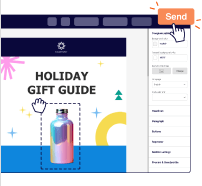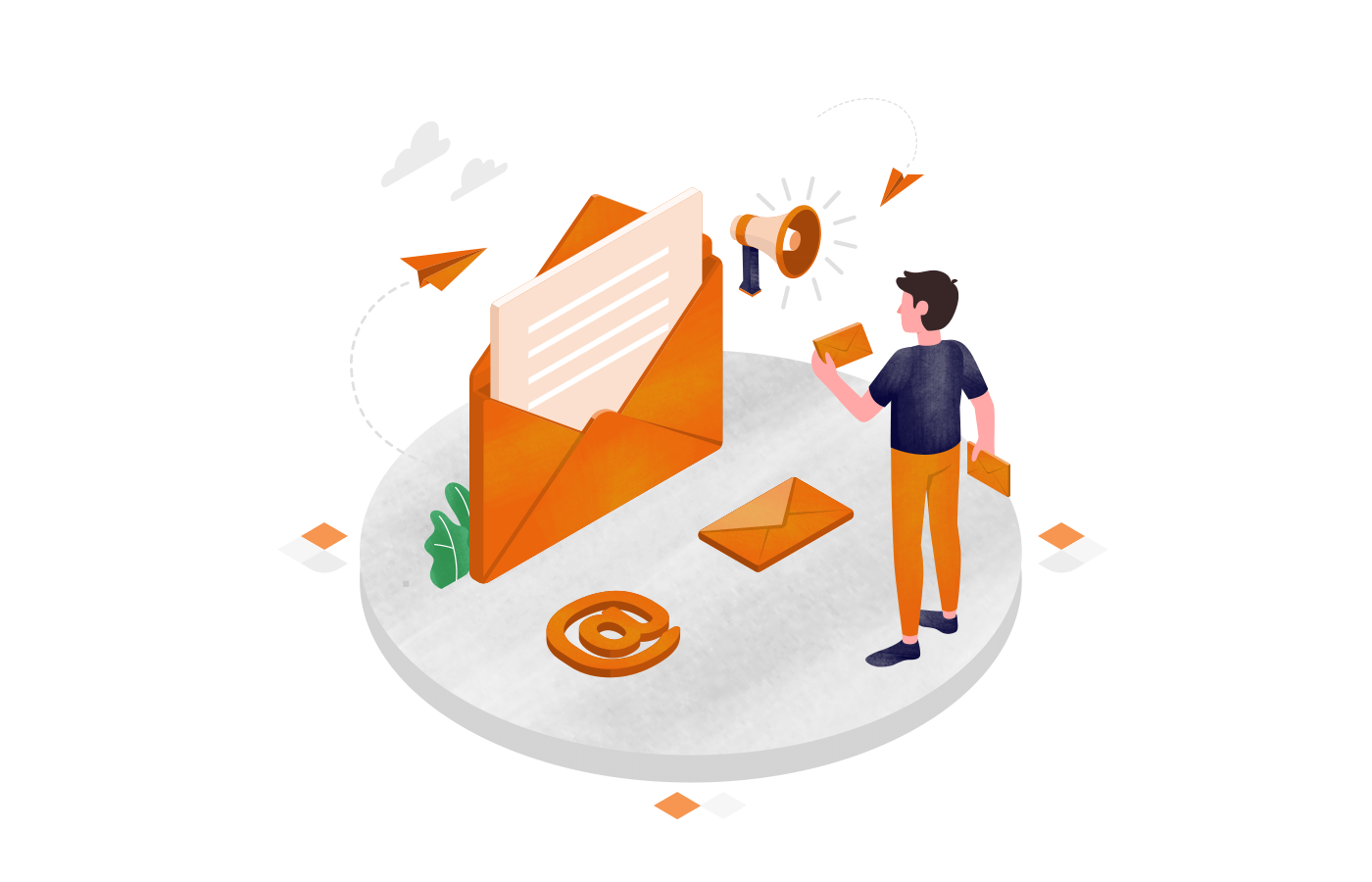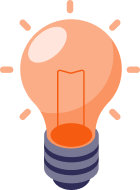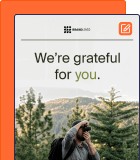Here’s an example of an interesting welcome email by Bubble Skincare: Did you know that 41% of marketers admit that email is their most effective marketing channel? That’s a compelling reason to think about email marketing seriously.
Over the last few years, we’ve analyzed dozens of email campaigns across industries and found what separates great email marketing campaigns from the good.
In this guide, we’ll walk you through 14 real-world email marketing examples that brought great results. From welcome sequences to cart abandonment saviors, we’ll break down what makes high-performing campaigns work, what you can learn from them, and how to apply the same tactics to your own email marketing strategy.
Let’s start.
What is an Email Marketing Campaign?
An email marketing campaign is a coordinated series of emails sent to a specific audience with the goal of achieving a particular outcome. You can nurture leads, promote products, or share valuable content through email campaigns.
These campaigns can be automated sequences, like welcome emails, cart abandonment reminders, or one-off newsletters tailored to current events or promotions.
Here’s why email campaigns are so crucial for businesses:
- Exceptional ROI. Email marketing ROI is one of the highest in the marketing world. For every $1 spent on email marketing, businesses see an average return of $36, equating to a 3600% ROI;
- Great for customer experience. 81% of small and medium businesses believe email marketing increases customer retention and helps acquire potential customers;
- Increasing relevance. 77% of marketing managers have reported an increase in email engagement in the last 12 months;
- Influence on consumer behavior. 60% of respondents say that marketing emails have influenced their purchases.
All these statistics point to one thing — email campaigns cannot be ignored and help in massive growth. And we’ve seen that time and again during our marketing efforts.
Take Icons8, for example. This creative resource platform partnered with Sender’s email marketing service to revamp their email marketing strategy, and the results were impressive.
Through smart email campaign management techniques, they were able to increase their click-through rates by 200% and email open rates by 33%. Furthermore, they also benefited because of a reduction of 80% in bounce rates.
Email marketing campaigns work if you know how to send effective ones. Now, let’s look at the different types of campaigns you can plan using email marketing software.
Types of Email Campaigns
Not all emails serve the same purpose. Each campaign type plays a specific role in the customer journey, from that first hello to the final “thank you for your purchase”.
We’ve closely seen how mastering the right mix of these campaign types turns mediocre engagement into a thriving and loyal audience.
Let’s look at five core types of email campaigns along with proven best practices to get it right.
Welcome Emails
Welcome emails are your first impression. They land when someone joins your list, so timing, tone, and clarity matter more than ever. The best welcome emails don’t just say “hi”. They show the reader what’s in it for them and invite them to explore.
More than 8 out of 10 people open a welcome email, and it generates 4x as many opens and 10x as many clicks as other email types. Why? Because the reader is most attentive right after signing up.
What makes a welcome email successful?
- Timing. Send it instantly after a user signs up—strike while interest is hot. Delays = lost momentum;
- Content. Start with a warm greeting, introduce your brand quickly, and set clear expectations for what’s next;
- Personalization. Even a simple first-name mention increases email open rates—but go beyond. Include relevant product categories, ask a question, or link to a quiz to make it interactive.
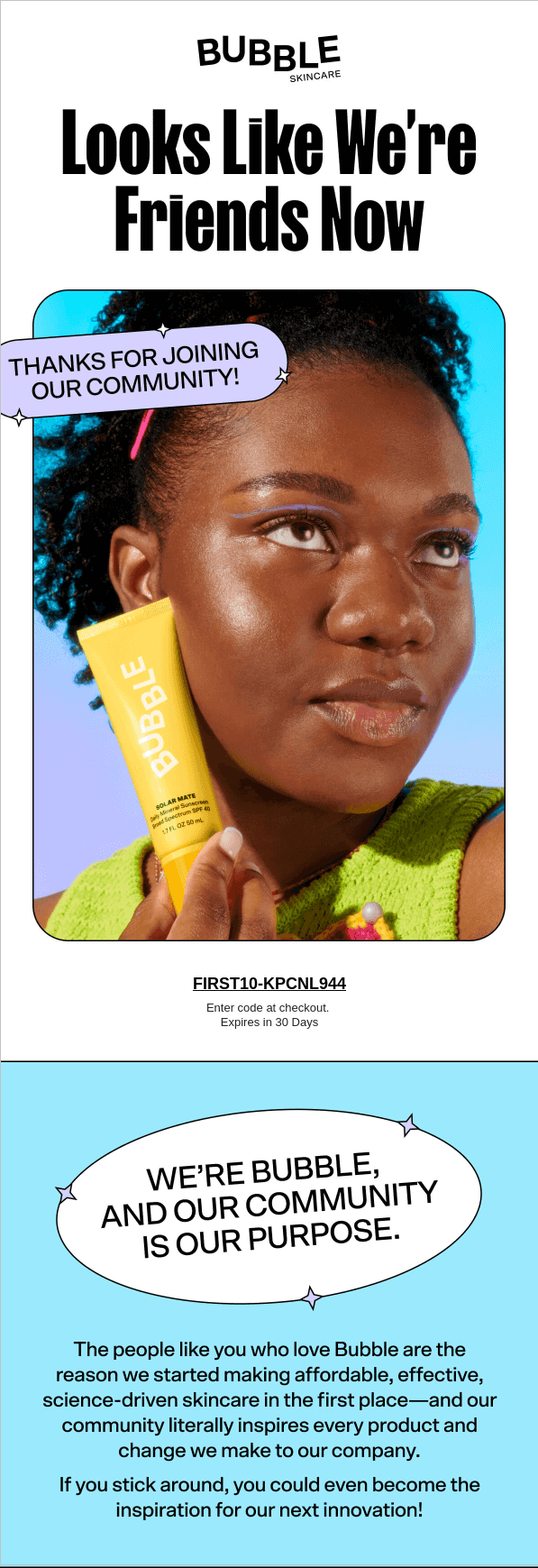
This email is a good example of how to welcome new subscribers because of:
- Headline hook. “Looks Like We’re Friends Now” immediately sets a friendly, Gen Z-aligned tone, less formal, more connection;
- Clear incentive. A prominent discount code with a 30-day expiry window encourages immediate action without pushiness;
- Community focused. Their message isn’t “shop now”—it’s “you’re part of something”. This builds emotional loyalty from day one.
Set up a welcome email flow to thank new subscribers and show you value them. Here are some best practices:
- Send it immediately after signup (don’t delay momentum);
- Open with a warm, friendly tone, not corporate jargon;
- Highlight what email subscribers can expect (content frequency, offers, tone);
- Offer a simple incentive (like a discount, freebie, or exclusive content);
- End with a CTA that invites, not pushes, for an action.
Newsletter Campaigns
These are your ongoing touchpoints to keep you top-of-mind in a crowded inbox. The best-in-class newsletters aren’t overly promotional. They blend updates, storytelling, education, and subtle nudges.
Newsletter campaigns are one of the most popular campaign types, used by 81% of marketers. What keeps readers opening them? Relevance, consistency, and a spark of brand personality.
Here’s an example of a brand newsletter by HUX:
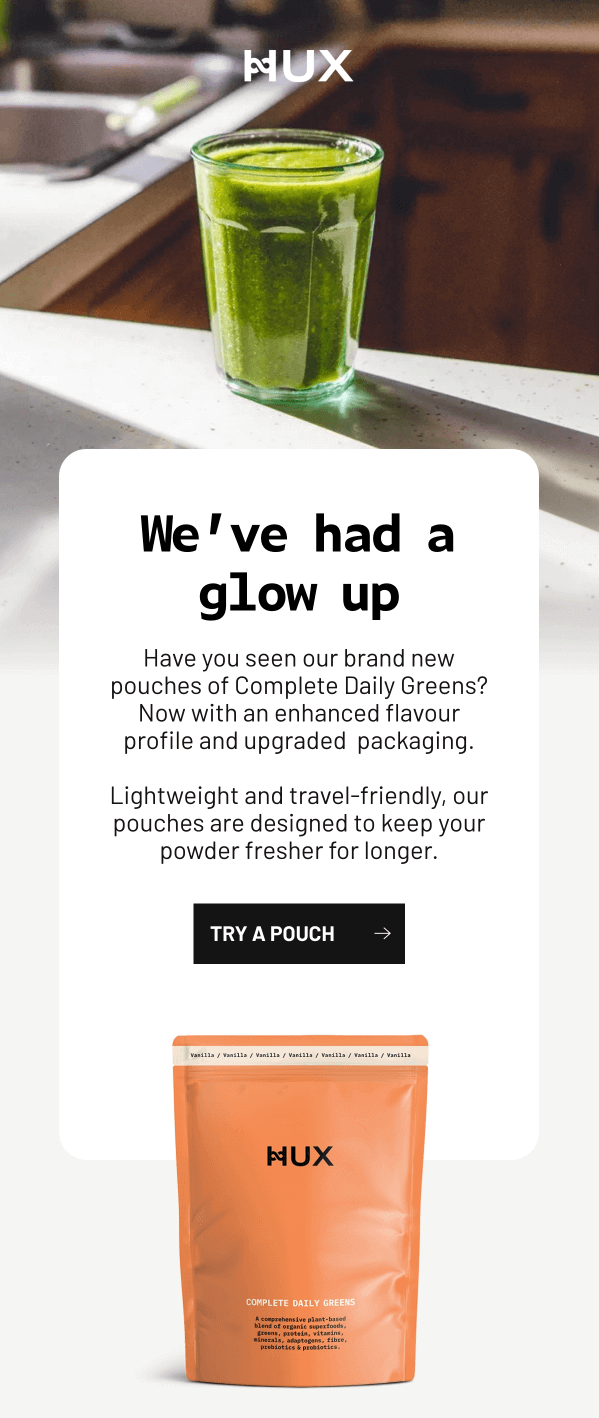
This newsletter sends a product update via newsletter and knows exactly how to make it interesting. Here’s why this works:
- Bold hook. “We’ve had a glow up” is playful, modern, and instantly curiosity-driving;
- Product storytelling. Instead of just announcing a new pouch, they frame it as a transformation (with better flavor, improved design, and usability);
- Relatable context. Lightweight, travel-friendly packaging? That’s not just a feature; it’s a lifestyle win.
If you’re planning to send a newsletter soon, here are some things to learn from this newsletter:
- Focus on value. Share updates, insights, or stories, not just sales pitches or offers;
- Use visuals strategically. Think of using lifestyle images, product shots, or unique design elements;
- Make it mobile-friendly. Over half of emails sent are opened on mobile devices. Make sure they look great on phones;
- Clear CTA. Don’t overload with buttons. One or two well-placed links are enough.
Also, remember to send your newsletters consistently (weekly, biweekly, or monthly — whatever you can maintain), and segment your email list based on the reader’s interests or activity for maximum impact.
Promotional Emails
Promotional emails are your digital pitch to drive attention toward your festive offers, product drops, and flash sales. But they don’t have to scream “SALE!” to be effective. A good promo email is a mix of urgency, design, and precision targeting the right person.
We recently ran a Valentine’s Day promo with a relatable copy and an urgency-driven discount offer. Have a look:
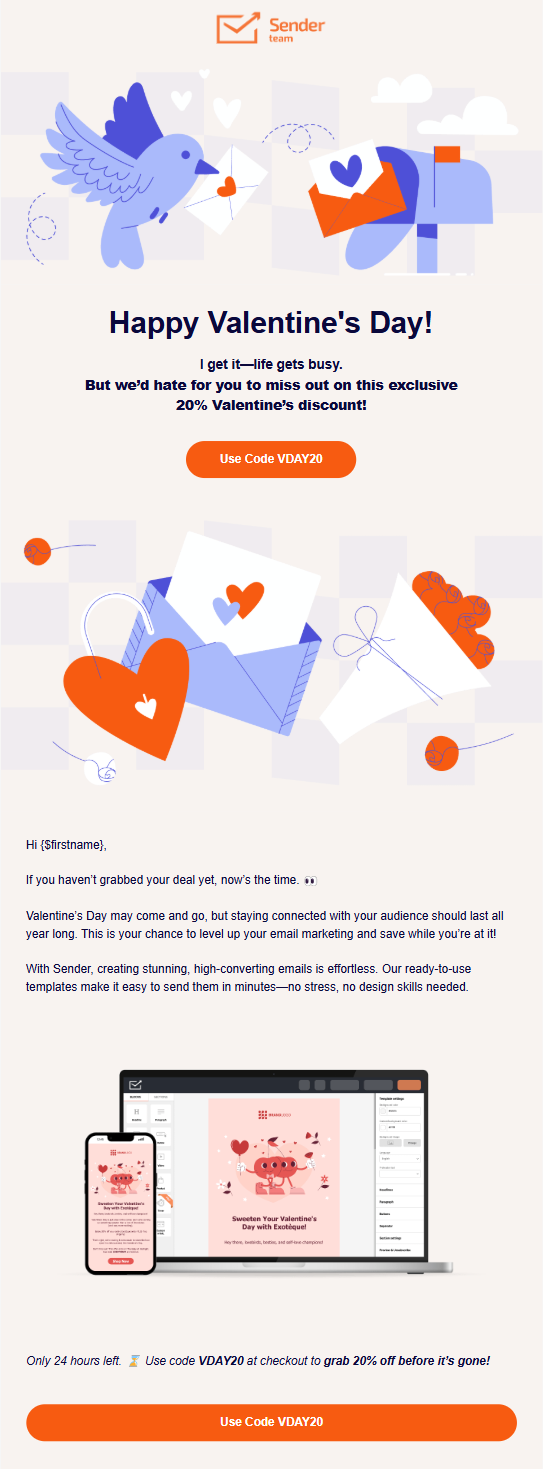
We A/B tested a “One-Day Only” vs. “This Weekend Only” promo—while both converted, the shorter deadline delivered 22% more clicks. Why? Fewer decisions = faster action.
Here are a few more things that we feel worked in our favor:
- On-point hook. “I get it—life gets busy”, tapped into routine challenges while softly nudging towards the offer;
- Urgency without anxiety. “Only 24 hours left” is mentioned at the bottom, creating FOMO without sounding desperate;
- Conversational copy. From “Now’s the time 👀” to “no stress, no design skills needed,”—the tone is casual and confidence-boosting.
Here are some best practices you can use for your own promotional emails:
- Send contextual offers. Launch around a specific event or urgency trigger (e.g., Valentine’s Day, Black Friday, etc.);
- Use a clear, benefit-first subject line. “20% Off Just For Today” is always better than “Check Our New Collection”;
- Lead with a strong, compelling hook or story. Add unknown facts about your products, use lifestyle shots, and share a BTS story, or graphics that support the offer;
- Compelling CTAs. Add your CTA buttons in prominent spots like top, middle, and at the end like a final push;
- Use urgency. Add timers and copy that emphasize limited quantities or “only for subscribers” tags.
Want to build high-converting campaigns like this one? Sender’s drag-and-drop editor and responsive email templates makes it a breeze —no design skills needed.
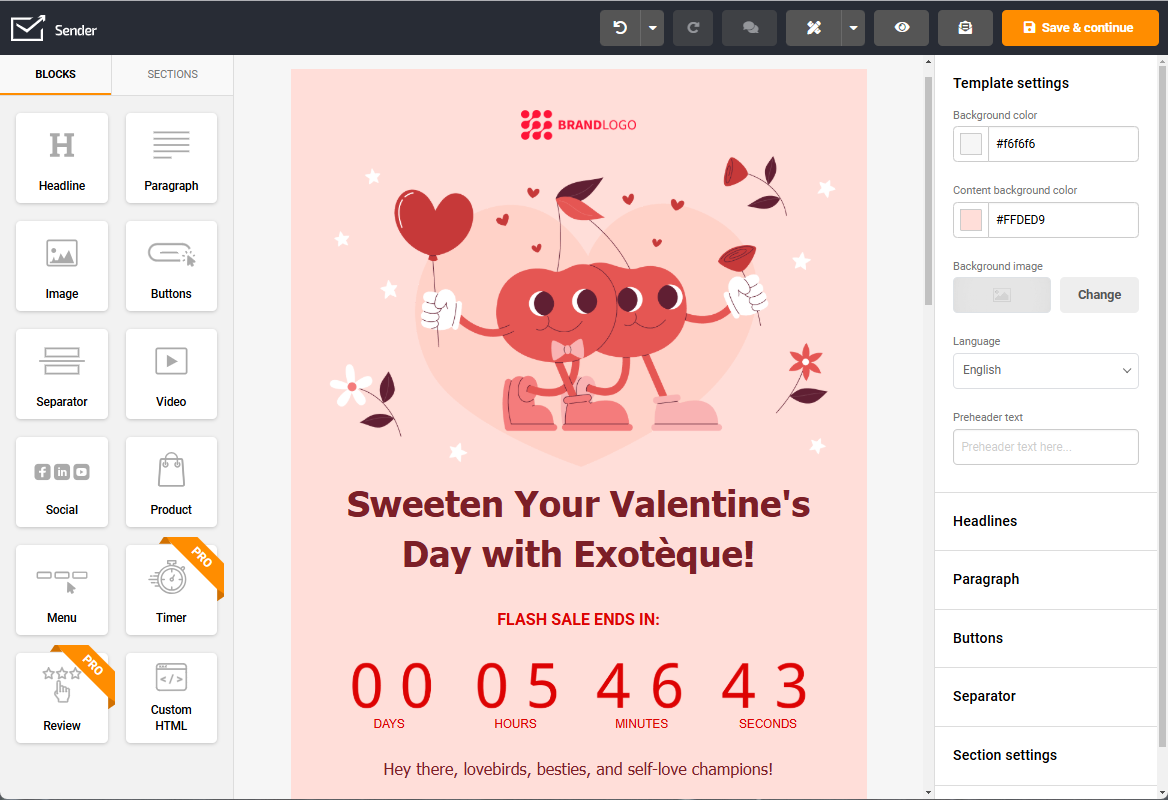
Transactional Emails
Transactional emails are an important part of your email strategy. They keep customers informed at every step and are triggered by user actions, like placing an order, resetting a password.
What we’ve found: subtle upgrades like brand voice, product recommendations, or helpful links in transactional emails can improve customer perception and even boost repeat purchases.
Here’s a great example of a transactional email by Ritual:
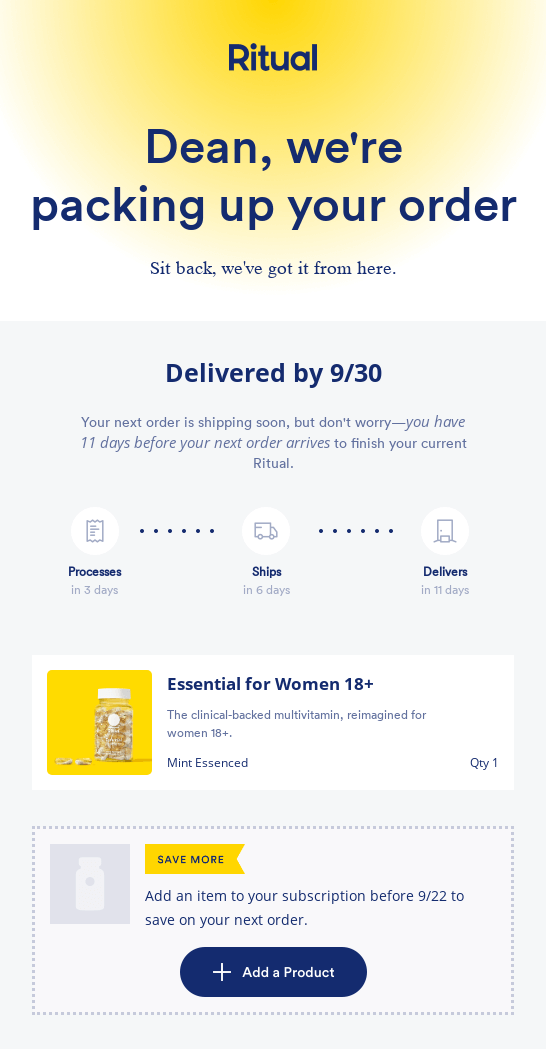
This order confirmation from Ritual has a lot of things to learn from. Here are the best ones:
- Personal touch. Starts with the customer’s name and a personal statement that feels direct and human;
- Timeline clarity. Instead of a vague “it’s shipped,” it outlines processing, shipping, and delivery steps with specific dates;
- Encourages action. Includes a smart cross-sell (“Add a Product”) with a time-sensitive offer.
This email reduces post-purchase anxiety while subtly opening the door for more purchases. Here are some best practices for your transactional emails:
- Instant delivery. Automate transactional email for instant delivery after a customer action;
- Personalize the email. Use the recipient’s name and reference their action;
- Be clear. Show relevant content clearly, such as order summary, estimated delivery, tracking link, etc.
- Increase trust through pertinent information. Give them the option to track their order, manage subscriptions, or contact support through relevant links.
Re-engagement Emails
Every list has sleepy subscribers. A good re-engagement campaign can wake them up if done right. These emails give people a reason to come back, whether it’s with exclusive offers or a friendly nudge.
Such emails are emotionally timed. They whisper, “We miss you”, or tempt with, “You’re missing out”, and the best ones strike a balance between being friendly and irresistible, like the one below:
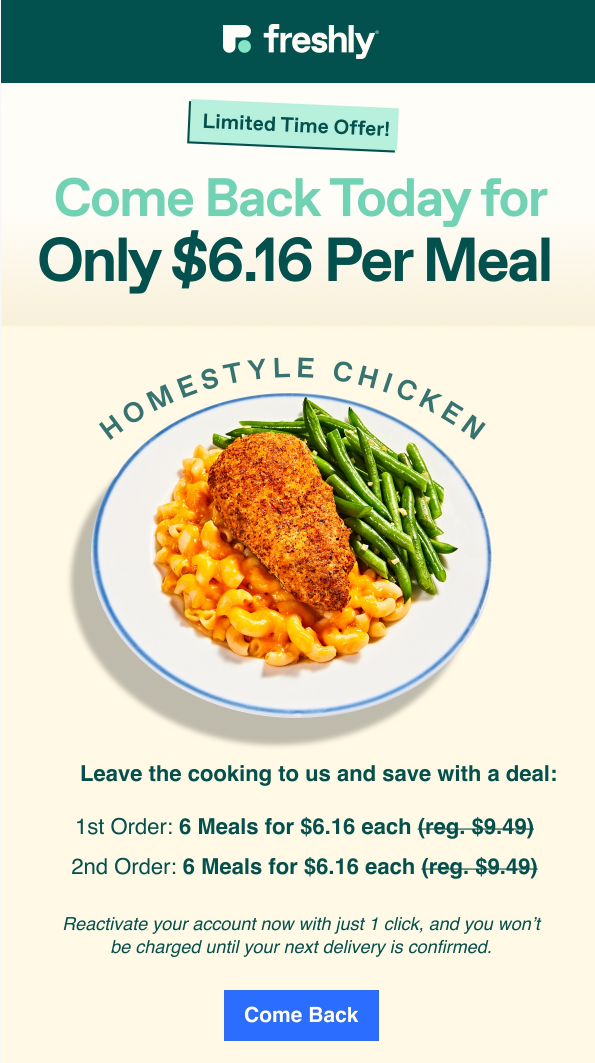
Freshly’s reactivation email gets a lot right, and it’s not just the homestyle chicken. Here’s everything we liked:
- Direct emotional hook. “Come Back Today” feels personal without being clingy;
- Clear offer. They lead with a specific, value-packed deal and showed it clearly;
- Sensory visuals. The hero image isn’t just food—it’s nostalgia on a plate, appealing to comfort and hunger;
- Low commitment CTA. ‘Come back’ looks friendly and doesn’t ask for an instant commitment, removing friction;
This email succeeds because it acknowledges that while past customers have left, it’s easy (and affordable) to return. Here are some best practices for you to use based on our understanding:
- Time it well. Send targeted campaigns to users who haven’t opened or clicked in 30–90 days;
- Spend extra time on subject lines. Use warm and curiosity-striking email subject lines;
- Give them a reason. Remind them what they’ve missed— advanced features, collections, community updates;
- Share a personalized offer. Offer a useful incentive like a comeback discount, free trial, or surprise gift;
- Make it frictionless. Words like “1-click reactivation” or “No commitment until delivery” instill trust.
Effective Email Marketing Campaigns
Now that you know different types of email campaigns, let’s look at brands putting them all into practice.
These successful email marketing campaigns show how the right mix of strategy, timing, and design can drive sales.
Thank You Emails — Wonder Valley
A thank you email signifies a warm gesture and is sent after a customer completes a purchase, signs up, or supports your brand. It humanizes your brand and turns a transaction into a relationship.
Wondering how you should structure your Thank you email? Take inspiration from this email by Wonder Valley:

This email is beautiful, and every element feels personal — from the founder’s note to the nostalgic visuals. It doesn’t try to sell; it tries to connect. The message is genuine, the design intentional, and the bonus playlist makes it feel like a gift, not a campaign.
Why it works?
- Builds emotional equity without pushing a product, which is ideal for retention;
- Founder sign-off makes it feel handcrafted, not automated;
- Bonus playlist deepens brand storytelling and improves delight.
Seasonal Email —- Sender
Seasonal emails are time-bound campaigns around special events, holidays, or cultural moments like Women’s Day, Diwali, Black Friday, or Back to School. They help you tap into the vibe of the season and ‘shared awareness’ about a popular event.
We’ve been sending seasonal emails for years now, and here’s what we did for Women’s Day:
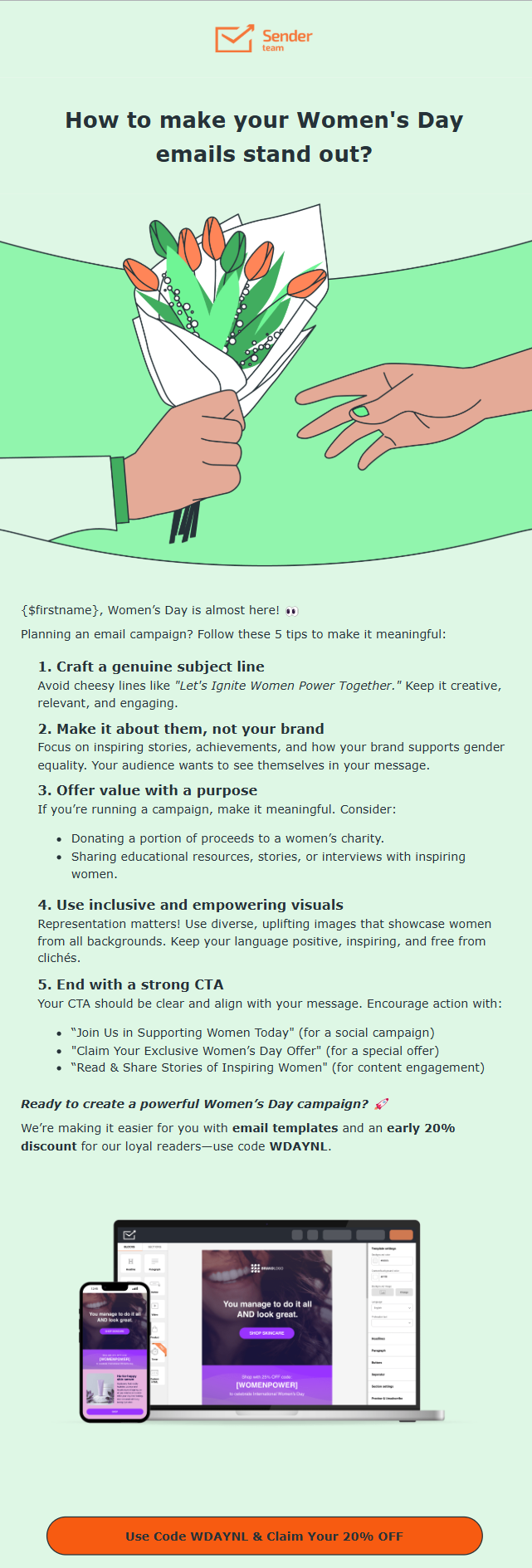
If you notice, this campaign doesn’t just wish — it tries to add value. We balanced it for people who want to send Women’s Day campaigns and added a subtle nudge with an offer.
Our top priorities when creating this campaign were:
- Educate first, sell second;
- Inclusive design and language;
- Create a balance between value and a time-sensitive offer.
And how did it perform? Let’s look at the performance briefly:
Campaign Performance
Our campaign followed a three-part strategy: educate, inspire, and convert.
The subject line ‘5 Tips for Your Women’s Day Campaign ’ achieved a 39% open rate, outperforming typical SaaS seasonal email averages.
The campaign was sent to a segmented list of almost 65,000 users, filtered by email engagement over the past 90 days and time zone to optimize send timing (Tuesday morning, 9:00 a.m. local time).
Key performance metrics:
- Open rate: 39%
- Conversion rate: 3.9%
- Unsubscribe rate: 0.1%
Bonus: We also sent out short reminder emails 4 and 6 days after the initial campaign. Interestingly, these follow-ups had similar open rates—and even higher click-through rates—than the original email. It just goes to show that a well-timed reminder can spark even more engagement.
So whatever you do, don’t skip those follow-up emails!
Ready to create email campaigns that actually get noticed? Grab your free HTML templates and start building stunning newsletters — without the stress!
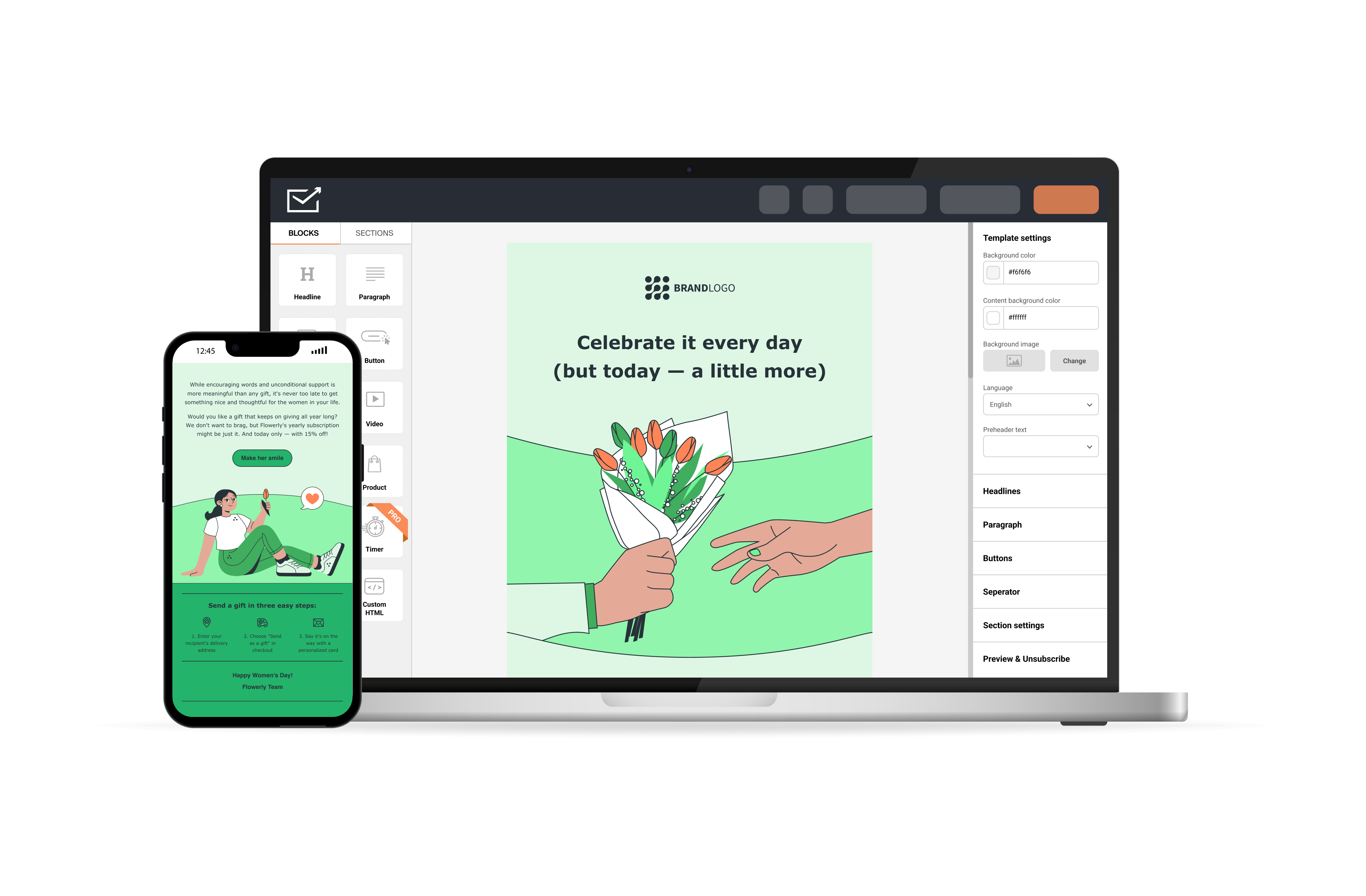
Educational Emails — Dollar Shave Club
Educational emails aim to inform and build trust. They’re used to teach your target audience something helpful via tips or advice that makes their lives easier.
Adding educational email campaigns to your email marketing strategy is always a good idea. Studies suggest that consuming educational content increases the likelihood of buying from a brand by 131%.
Here’s a great example of how you can create an educational email without boring customers:

This email nails education with personality. Instead of educational emails, which often come with long walls of plain text, they used a catchy visual to introduce the problem.
The short paragraph explains why it’s a good idea to put on sunscreen. It informs without being too preachy and sells without forcing.
Why it works?
- Explains a common problem using a scroll-stopping visual;
- Infuses education with brand voice;
- Connects learning to product use naturally, not forcefully.
Feedback & Survey Emails — J.Crew
Feedback emails are sent shortly after a customer makes a purchase or uses a service. Their purpose isn’t just data collection but also building relationships.
A well-timed review request shows existing customers that their opinions matter while generating valuable social proof. Here’s an example by J.Crew:
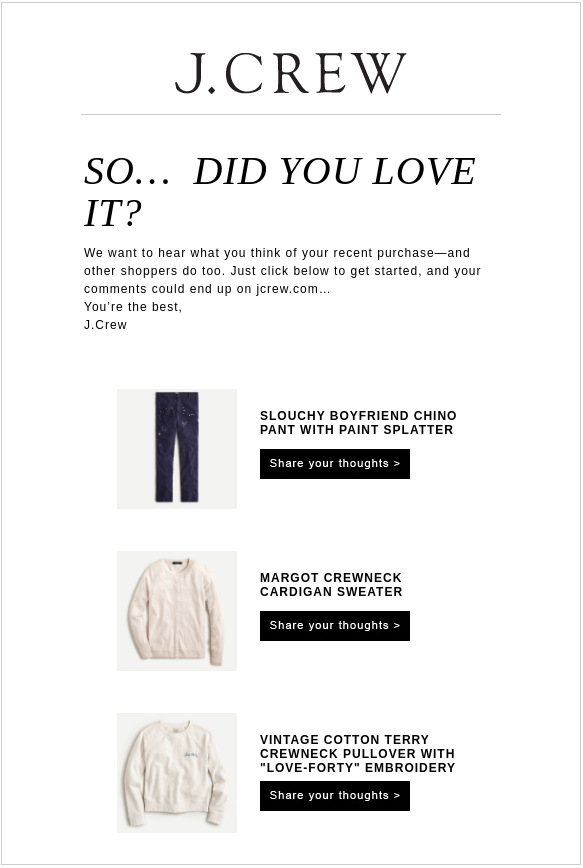
The email is minimalist and gives direct CTAs to users to share their opinions about their recent purchases. The writing is direct and impactful. There’s no extra element in the email, which reduces distraction and directs readers to the review page.
Why it works?
- Minimalist design with zero distractions;
- Contextual and relevant ask about past purchases;
- Direct CTA buttons asking to share thoughts.
Nurturing Emails — Wix
Email nurturing campaigns are sent to nurture prospects or website traffic to influence them to buy something. It can even be targeted at inactive prospects or customers who have not engaged with your brand for some time now.
The key purpose is to move them further into the buyer’s journey and make them buy something from your store. Efficient nurturing practices with timely follow-ups help companies increase conversions by up to 50%.
Here’s how you can use email marketing campaigns to nurture your leads:
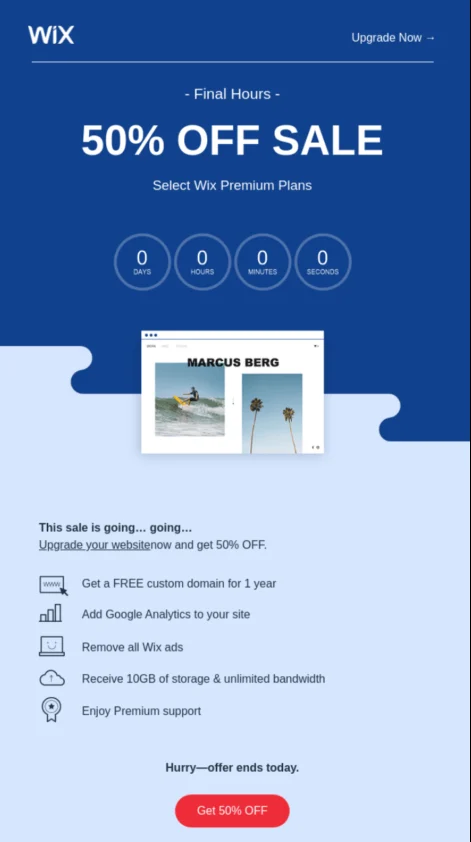
This email from Wix is sent to free or trial users on the verge of churn. Instead of a generic push, it combines a compelling discount with a countdown timer to create urgency.
But what’s more strategic? It addresses the #1 friction point for SaaS users: price hesitation.
Reframing the offer as limited-time value makes the leap to a paid plan feel like a smart (not pressured) decision.
Why it works?
- Great offer focused on addressing price apprehension;
- Countdown timer, adding a sense of urgency to act;
- Contrasting CTA button highlighting price savings.
Abandoned Cart Emails — Luxy Hair
Abandoned cart emails are triggered when a user adds products to their cart but doesn’t complete the checkout.
Timing is critical to sending such emails. In fact, sending the first email within an hour can recover up to 16% of lost revenue.
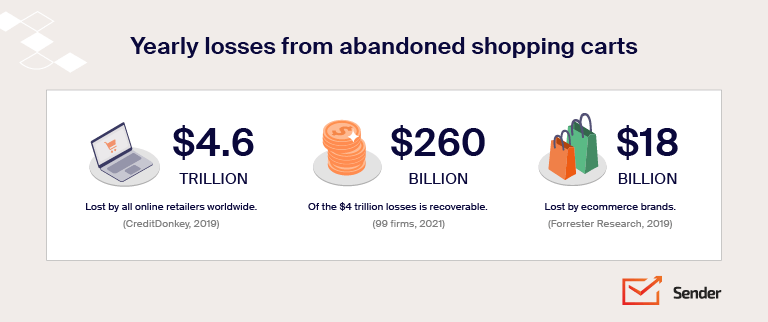
Automating a cart abandonment email can be profitable to win back your customers and increase your sales revenue. Here’s an interesting cart abandonment email template example by Luxy Hair:
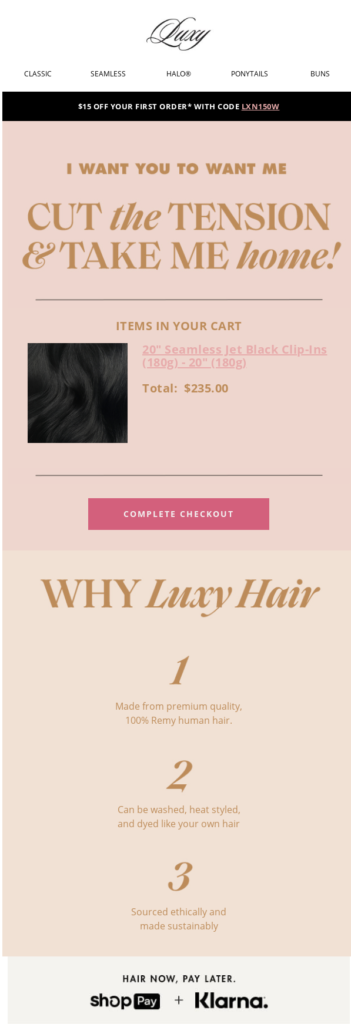
Luxy Hair’s email doesn’t chase the abandoner — it charms them. The witty one-liners in the header with a bold CTA button to complete checkout make them give a second thought to their cart. However, an extra discount or offer would have made this email more compelling.
Why it works?
- Witty copywriting in the header;
- Solid reasons to choose the brand, added prominently in the email;
- Special ‘Buy Now Pay Later’ offer to reduce friction.
Abandoned Carts Rates Across Different Industries
Cart abandonment is a big problem for the ecommerce industry.
According to the most recent estimates, 57-84% of carts are abandoned across different industries. Here are some industries with the highest cart abandonment rates:
| Industry | Cart Abandonment Rate |
| Luxury & Jewelry | 81.68% |
| Home & Furniture | 78.65% |
| Fashion accessories & Apparel | 76.48% |
| Beauty & Personal Care | 72.04% |
| Multi-brand Retail | 68.07% |
| Consumer Goods | 65.41% |
| Food & Beverages | 58.23% |
| Pet Care & Vet Services | 53.19% |
Every abandoned cart is money left on the table. Wondering how much online businesses actually lose? The numbers are staggering.

However, a lot of the drop-offs can be recovered with automatic cart abandonment sequences. In fact, sending a cart abandonment email at different intervals can yield great conversion rates:
| Period of sending an abandoned cart email | Recovery rate |
| After 30 minutes | 15% |
| After 20 minutes | 13% |
| After 1 hour | 16% |
| One day (24 hours) | 11% |
While abandoned cart emails are a powerful recovery tool, preventing drop-off in the first place is even better. Most shoppers abandon carts due to hidden costs, complicated checkouts, or lack of urgency.
Here are some proven ways to reduce cart abandonment:
- Show shipping costs early—no surprises at checkout;
- Offer guest checkout to remove login friction;
- Use exit-intent popups with time-sensitive offers;
- Add product reviews and trust badges near the “Add to Cart” button;
- Retarget cart abandoners on other marketing channels with special offers;
- Include real-time stock notices (“Only 3 left!”) to trigger urgency.
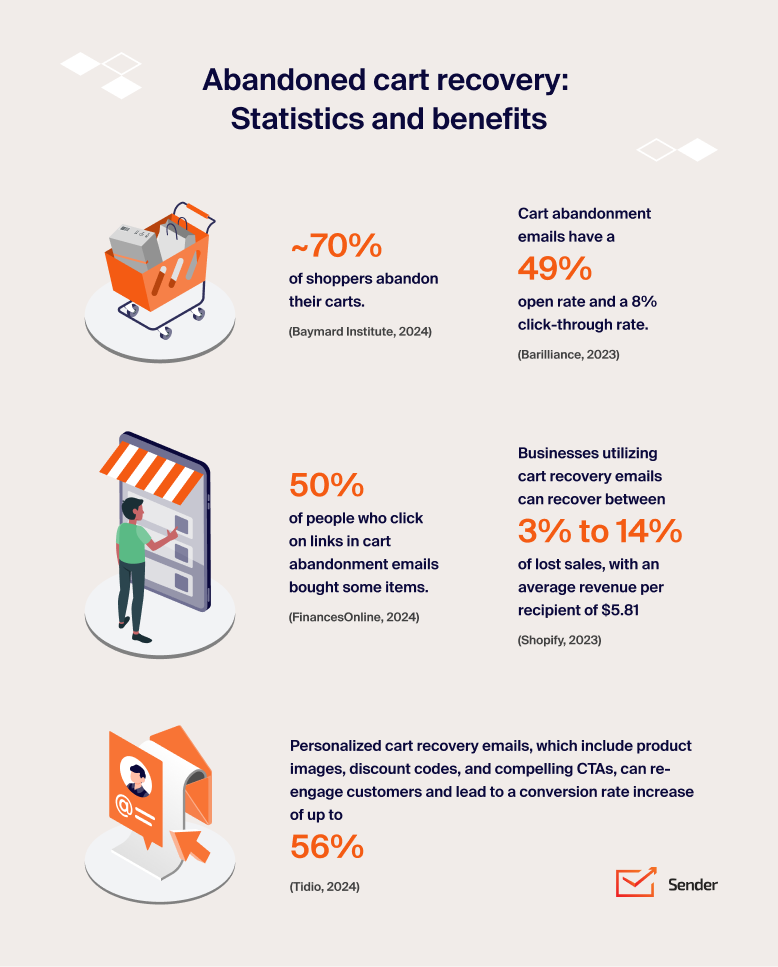
Birthday & Anniversary Emails — L’Occitane
Happy birthday emails are personalized campaigns that surprise subscribers with exclusive offers or gifts on meaningful dates. These aren’t just feel-good messages; they actually make people click and shop.
Studies say that happy birthday emails generate over twice the revenue of bulk promotional emails. And anniversary emails are even better. They generate nearly seven times more revenue than bulk promotional emails.
They’re best scheduled a few days before the birthday or milestone to give customers time to redeem their reward. Here’s a beautiful example with personalized content by L Occitane:
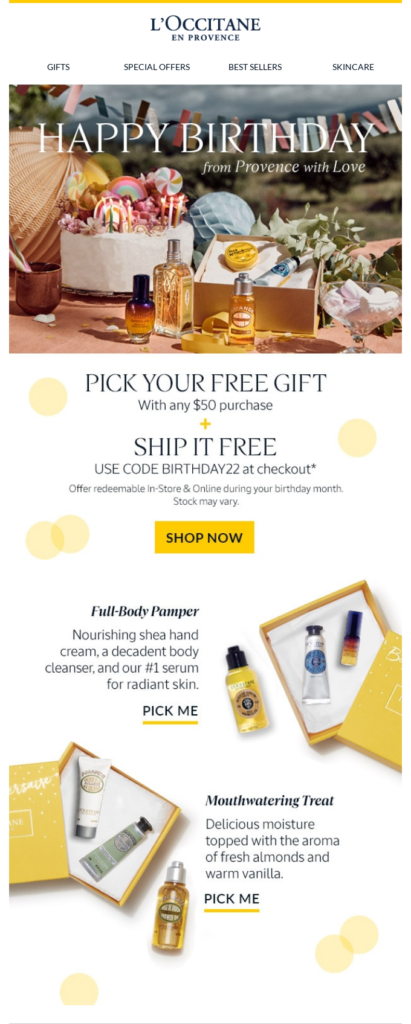
This email from L’Occitane strikes the perfect emotional tone. It’s warm and elegant, and offers a free gift and shipping with any birthday purchase, but it doesn’t stop there.
Contextual product suggestions and luxurious visuals reinforce the premium brand experience while still feeling personal.
Why it works?
- Offers a real incentive tied to a personal milestone;
- Dynamic content in the form of recommendations based on past behavior;
- The design feels like a birthday card, not a sales pitch.
Promotional Emails — beats
Promotional emails are designed to share your offers, special launches, or promote a sale event. They’re most effective when timed around seasonal shopping events. But with inboxes flooded daily, standing out requires clarity, timing, and restraint.
Look at this minimal yet impactful promotional email example by beats:
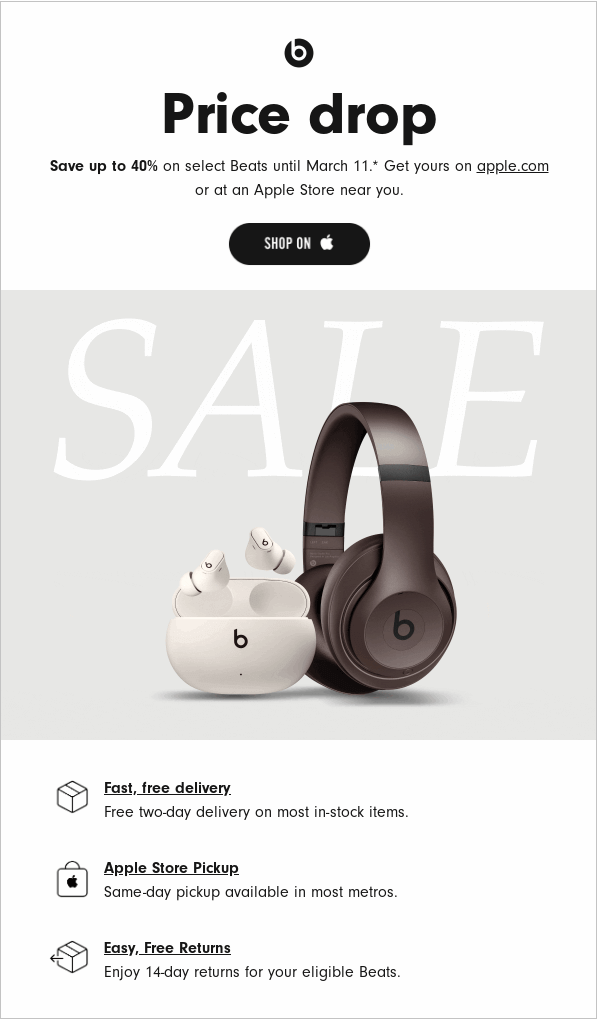
beats keeps it clean and focused. A bold subject line announces a price drop on a flagship product.
High-resolution visuals show the product in detail, while quick-hit bullet points highlight shopper benefits. The urgency is subtle but smart: mentioning the final date near the CTA nudges action without pressure.
Why it works?
- Crisp, minimalist layout draws immediate attention to the offer;
- Deadline hint boosts urgency without triggering banner blindness;
- Benefits are simplified into skimmable bullets—no cognitive overload.
Drip Campaign — Pulp & Press
A drip campaign is a series of automated, behavior-triggered emails designed to guide subscribers through a journey—onboarding, purchase, or retention.
Unlike standalone blasts, drip emails are sent in response to user actions, making them timely and relevant.
Here’s a drip campaign by Pulp & Press that’s sent automatically after purchase:
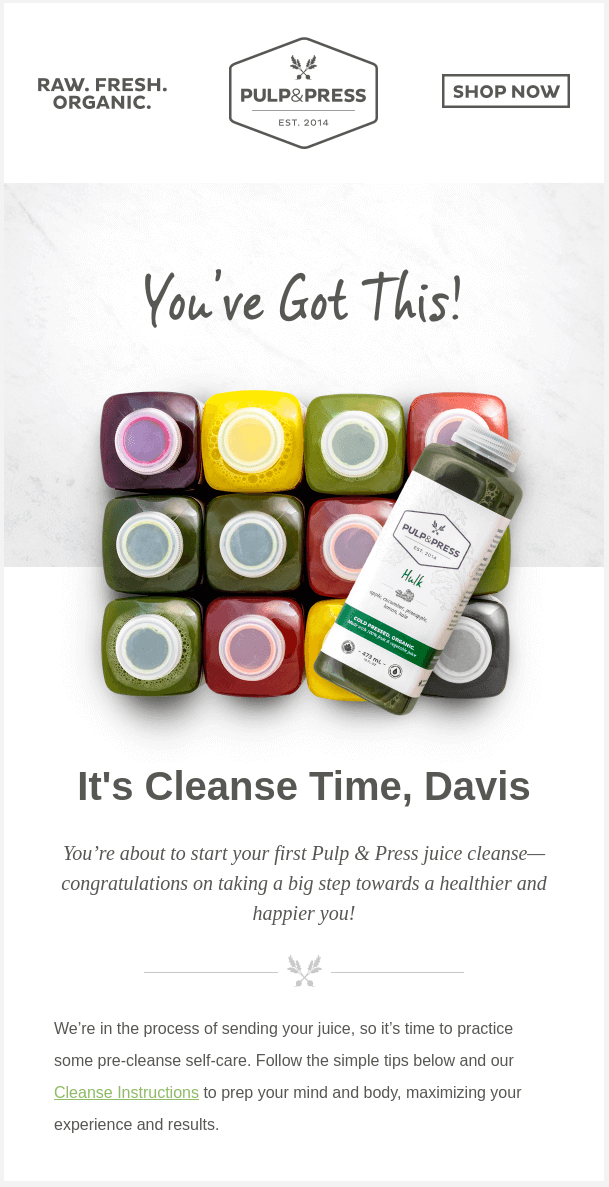
This email lands after a customer places an order and is part of a drip flow aimed at building trust and reducing post-purchase anxiety.
It combines visual storytelling (clean product imagery) with actionable info (how to use it). The tone is encouraging, making the user feel reassured and cared for—not just sold to.
Why it works?
- Perfectly timed in the journey—turns a transaction into anticipation;
- Adds value with how-to content, not just order confirmation;
- Reinforces trust while boosting satisfaction and long-term retention.
How to Create an Effective Email Marketing Campaign?
After seeing all the interesting email marketing campaigns above, you must be eager to start creating campaigns for your business.
Before you do that, here are some tips to help you create high-converting campaigns, easily:
Plan Your Goals
A successful email campaign starts with a purpose and clear business goals. Always ask yourself if you’re creating the campaign to nurture leads, attract new customers, or promote an offer.
Without a clear goal, even the most thoughtful emails can underperform. In fact, marketing managers who set clear goals are 376% more likely to succeed in their outcomes.
Here’s what you should do to set clear goals:
- Define your campaign type. Welcome, promo, newsletter, etc.
- Identify success metrics. Will you track open rates, CTR, conversions, or something else;
- Visualize before execution. Set timelines and email automation logic before you draft a word.
Get to Know Your Audience
Your campaign is only as good as your understanding of your audience. The best-performing emails feel personal because they are personalized to the customer’s behavior or preference.
A technique that most marketers use is called email list segmentation. In fact, the marketers who segment their audience increase sales and email marketing revenue by 760%.
Segmenting your contact list helps you personalize the message as well as the moment you send it. Here are some ideas to segment your audience:
- Categorize your mailing lists based on user demographics like age, gender, location, etc.;
- Group them based on behavioral data like past purchases or site activity;
- Segment them based on their subscription source, such as quiz results, landing pages, ad opt-ins, etc.
Icons8 implemented audience segmentation in their email campaigns. This helped them deliver relevant content, resulting in a 33% increase in open rates and a 200% boost in click-through rates.
Write Content That Clicks
Good copy doesn’t just inform; it moves. Focus on subject lines to create intrigue, body copy to empathize, and CTAs that guide action.
Here’s why you should focus on content:
- 47% of email recipients open an email based on the subject line alone;
- 69% report emails as spam based on irrelevant content.
If you’re clueless about how to write good email content, here are some tips:
- Hook readers with subject lines under 9 words;
- Write as if you’re talking to one person—not subscriber lists;
- Remove fluff. Every sentence should be crisp and direct.
When in doubt, remember — clarity over cleverness always wins.
Use Personalization
Personalized emails deliver 6x higher transaction rates. However, email personalization is not just about adding a first name tag to subject lines.
Go beyond first-name tokens. Here are some ideas:
- Recommend products based on browsing history;
- Send emails triggered by behavior (e.g., abandoned cart, category visited);
- Use location and past purchase data to drive relevance.
The goal isn’t to leverage automation (or smart tags). It’s to make users feel special. When users feel seen, they click.
Add a Call-to-Action That Stands Out
Your CTA is the conversion point—make it count. Think of your CTA as the finish line of a well-run race. Don’t trip there.
Bold buttons, whitespace, and positioning above the fold all matter. Whether it’s a “Shop Now”, button, or something interesting, it needs to be:
- Visible (don’t hide it in text!);
- Clear (avoid vague phrases like “Click here”);
- Emotionally framed (“I want this” > “Submit”)
Also, remember that emails with a single CTA increase clicks by 371% and sales by 161%.
Track Your Email Engagement
You can’t improve what you don’t measure. So, keep a close eye on open rates, click-throughs, unsubscribes, and bounce rates to understand what’s working.
According to industry benchmarks, a good open rate is typically between 20-30%, while a healthy CTR is around 2.5% or higher.
If your numbers fall short, test subject lines, timing, or content. Your data isn’t just feedback, it’s your guide to optimize your email engagement tactics.
Monitor Your Campaign Metrics
Once a campaign is live, your job isn’t done, it’s just getting interesting. As we said above, you need to regularly measure and monitor important metrics:
Keep an eye on:
- Conversion rate (revenue per email sent);
- Email heatmaps (where people are clicking or dropping off);
- A/B test results (subject line vs. CTA variations).
Email marketing platforms like Sender offer real-time metrics dashboards. Use them wisely to boost your email marketing success. Even a 0.5% lift in CTR can mean thousands in revenue over time.
Remember, the brands that win measure, tweak, and repeat their best-performing campaigns.
Key Components of an Email Marketing Campaign
An email campaign consists of several important elements, which, when combined, create the desired impact. Let’s look at the different components of an effective email campaign and see how you can nail them.
- Subject line. It’s the deciding factor for your email’s performance and your first opportunity to make an impression on your subscribers;
- Preview text. Preview text appears alongside the subject line and provides additional context to entice customers to open your email;
- Call-to-action (CTA). Call-to-action is the specific action you want your recipients to take after reading your email and is detrimental to driving conversions;
- Design and layout. Professional design is essential to attract and engage subscribers. So, choose email templates with a responsive and clean design that enhances readability and guides readers toward your CTA;
- Segmentation. Segmentation involves dividing your email list into smaller groups for personalizing your email campaigns;
- Timing. Timing matters as much as what’s inside your email. Scheduling emails during early morning hours, such as between 3:00 and 7:00 a.m., has been associated with increased engagement, as emails are more likely to appear at the top of recipients’ inboxes when they start their day.
Send Stunning Email Campaigns with Sender
Tired of email marketing tools that overpromise and underdeliver? Sender gives you everything you need to run high-converting email campaigns without being overwhelmed.
Whether you’re welcoming new subscribers, launching a sale, or want to update subscribers with the latest drops, Sender’s user-friendly drag-and-drop editor and library of professionally designed templates is a big help.
No design skills? No problem—just pick a layout, tweak the copy, and hit send. Start with an email service provider that offers 15,000 emails/month to 2,500 subscribers for free, forever. No credit card needed. No catch.
